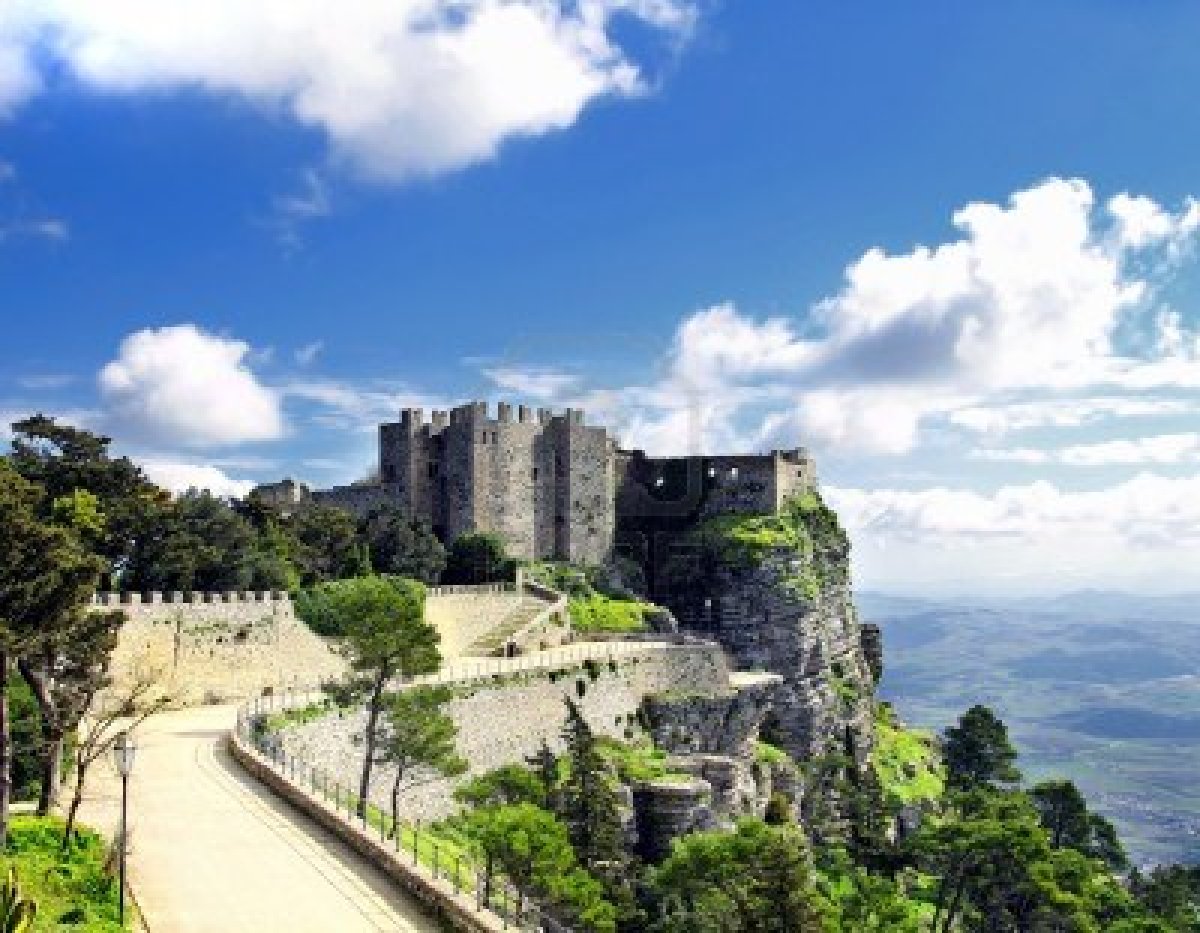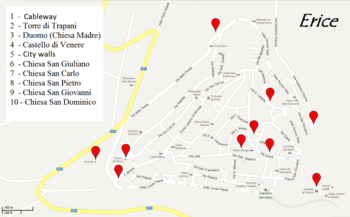Ancient Erice
Erice is a village in the province of Trapani on Sicily in Italy.
Understand
The entire municipality of Erice has 28,000 inhabitants. Most of them live in the Casa Santa district which is directly adjacent to Trapani. Only less than 500 people live in the old mediaeval fortification which is unique located on top of the 715 meter high Erice mountain. The city has wonderful views. On a clear day, the Mount Etna volcano, on the other side of the island, can be seen. Because of its height, it can be cold in winter. On some days, the mountain is hidden in clouds of fog. Even on summer evenings, it’s advisable to have a sweater within reach.
History
The ancient name of Erice was Eryx (Eρυξ in Greek). With Drepanon, Segesta and Talla, it belonged to the largest cities of the Elymian people. For the Carthaginians Erice was of great strategic importance. After the Romans had defeated the Carthaginians, the significance of the city decreased, and it fell into disrepair. The Arabs, who had gained a foothold on Sicily in the 9th century, called the virtually uninhabited mountain Gebel-Hamed. After the conquest of the Normans, the city was rebuilt, under the name Monte San Giuliano. The city walls and bastions were restored. During the Sicilian Vespers (the revolt of the Sicilians against Charles of Anjou), the city choose the side of the lords of Aragon and was rewarded with the construction of the cathedral. In later years, many buildings were realized within the walled city. During the Fascist period, the city regained its original name Erice.
Get in
By car
Two roads lead to Erice. SP3 from Valderice in the east, and SP31 from Casa Santa in the west. SP3 continues further south to Trapani.
By bus
From Trapani railway station Ast buses run within 40 minutes to Erice.
By cableway
In Casa Santa, part of Erice but adjacent to Trapani, a cableway runs up to the old town. The cableway base station in Casa Santa is located at the beginning of road SP31. From the centre of Trapani this station can be reached by bus 21 and 23. A cableway return ticket costs €6,50. (Opening hours: mon: 1pm-8pm. Tue-Fri 8:10am-8pm. Sat 10am-10pm. Sun 10am-8pm). The mountain station is located close to Porta di Trapani, one of the old city gates.
See
The streets and alleys have been renovated in recent years. Due to this the town looks a bit artificial, but the historic buildings and the stunning panoramic views remain. Be aware that if you visit Erice out of season some sites may been closed.
- Duomo, Chiesa Madre (3) – The Cathedral of Erice is built early 14th century.
- Castello di Venere (4) – Castello Pepoli is part of Castello di Venere. It’s a Norman castle built on an impregnable rock. Only the watchtower has left.
- Old city wall (5) – With the gates Porta di Trapani, Porta del Varmine and Porta Spada from the Norman period.
- Churches (6 t/m 10) – Most churches are built in the 17th century. San Pietro is from the 14th century.
- Views
- Park Balio
Do
Get information at the tourist office near Porta di Trapani (Phone +39 0923869388) and make a city walk. If you have time it is worth making a return to Trapani by cable car. It takes about 10 minutes and you have a magnificent view. In Trapani you can take a taxi or a bus to the centre.
Buy
- Ceramics and carpets
- Local sweets:
-
- Bocconcini di Erice, marzipan with jam and liqueur
- Genovese alla crema, sweet cakes with icing sugar
- Mustaccioli, oldfashioned biscuits from the local monastery made from flour with honey and anise liqueur
Eat
- Monte Giuliano, Vicolo S. Rocco, 7, ☎ +39 0923869595, e-mail: ristorante@montesangiuliano.it. Traditional kitchen with an outdoor terrace in summer.
- La Prima Dea, Via Vittorio Emanuele, 17, ☎ +39 0923869223, e-mail: info@laprimadea.it. Traditional kitchen
- La Pentolaccia, 17, G.F. Guarnotti, ☎ +39 0923869099, e-mail: info@ristorantelapentolaccia.it. Traditional kitchen



